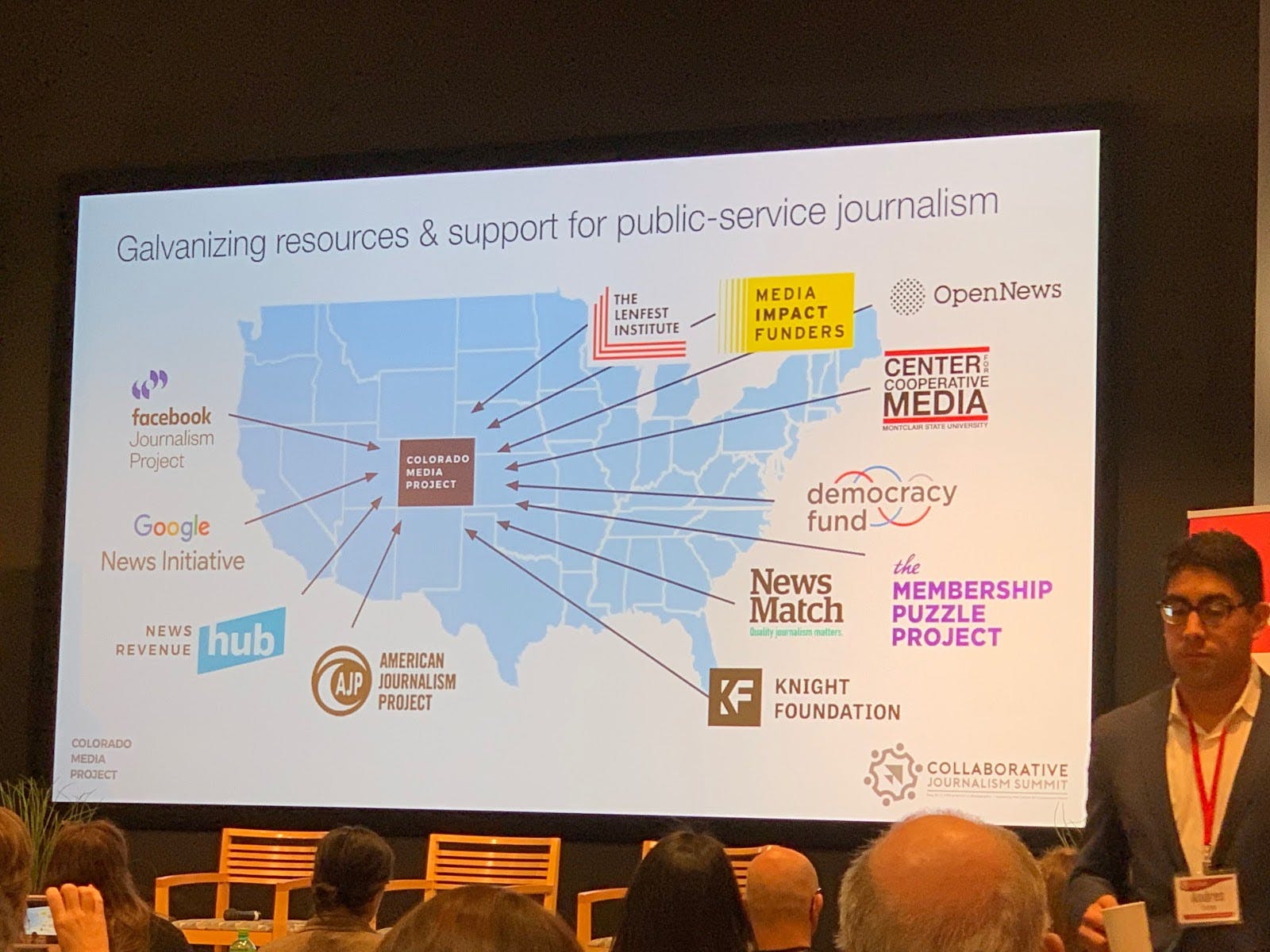
How to Build a Sustainable Local News Organization
You are on a mission. You’re tired of hearing the bad news about local news and its deleterious effects on civic engagement and democracy: The layoffs, the cutbacks, the mergers and potential mergers of large newspaper chains. So now is your time to act, to launch a new local news outlet that will provide the coverage of your community that has been sorely lacking for years. You will hold the powerful to account, celebrate inspirational human stories and make a real difference in your locale.
But how? There have been scores of failures in the local news market, both in print and online, so how will you find the winning business model, the right investors, the perfect technology, the helpful support networks – and most of all, the right staff that reflects the diversity of your town or neighborhood? Talk about equity and inclusion becomes action as you staff up your new publication.
It’s a tricky business, but one that can be fruitful because the time is right. Knight Foundation, Google and Facebook have pledged to spend $300 million each over the coming years to support local news, and the projects they have already funded can help jump-start your venture. In a difficult climate for local news, these potential funders, supporters and collaborators can make all the difference between success and failure.
Funding Sources
What’s amazing about this moment is the galvanizing of resources to help out new local news ventures being launched in the vacuum left by failing newspapers. One extraordinary example is the Colorado Media Project, which rose out of the controversial moves made by the Denver Post’s hedge fund owners, leading to an editorial revolt. You can see from this picture (below) that there is an incredible array of supporters and allies for the new project, from foundations to technology giants to support organizations.
In the realm of funders, you have to look closely at the American Journalism Project, which will be funding an array of new “civic news organizations” or CNOs around the country. The AJP isn’t a typical funder, as it practices “venture philanthropy,” which means it is not expecting outsize returns like a venture capital fund.

“We think of AJP as modeled on venture philanthropy, with catalytic support to help CNOs move toward sustainability,” said Jason Alcorn, vice president of operations at AJP. “These are structured as grants, not as investments where we expect to make a return. The parallel with venture capital, and the need we have identified in the civic news field, is that there’s not enough capital for organizations to make great hires and invest in the revenue side staff…We won’t ask for our money back, that stays in the organization, and serves to increase revenue generating capacity in the organization. Ultimately our goal to increase the resources for newsgathering in communities around the country.”
Alcorn said that funding would help out CNOs on a case-by-case basis, but AJP is hearing that needs are strongest in recruiting, hiring and retention—especially on the business side.
Another funder to watch is the Lenfest Institute for Journalism, based in Philadelphia, which was started in 2016 with an endowment from cable TV entrepreneur H.F. “Gerry” Lenfest and has since continued to build its resources through local and national fund raising. The Lenfest Institute is focused on supporting sustainable business models for important local journalism.
There are currently three interesting grant programs for media startups: the Local News Business Model Challenge, the Philadelphia News Ecosystem Collaboration Grants and the Knight-Lenfest Local News Transformation Fund. The first focused on projects that explore new business models or products for news, and included both publishers and non-publisher grantees such as Pico (audience revenue platform) and SembraMedia (Spanish-language news media entrepreneurship network). The second focused on projects that would help Philadelphia news media and other civic organizations work together in the public interest, such as the Cypher Philly Initiative (civic tech/data journalism) and Philly ResPOND (leveraging news media for the prevention of drug overdoses). The third will offer broad support for media innovation and collaboration both in the Philadelphia region and nationwide.
The Lenfest Institute takes an “ecosystem view” of news media supporting a broad array of collaborative media including digital startups, multi-cultural and traditional newspaper media, according to Jim Friedlich, executive director at Lenfest. “We have a significant commitment to an ecosystem approach, here in Philadelphia and beyond,” said Friedlich. “We are engaging digital startups, leveraging partnerships with public radio, and working with media makers of color, as well as investing substantially in the flagship Philadelphia Inquirer.” By way of example, Friedlich cites the first grant from the newly formed Knight-Lenfest Local News Transformation Fund in support of Resolve Philadelphia, for a reporting initiative called “Broke in Philly,” a collaboration of over 20 organizations in Philly covering poverty and economic justice.
This ecosystem approach to news has become more common among funders that are trying to understand the many ways that community members get, share, and act upon information. For example, learn more about how the Democracy Fund defines news ecosystems here.
The Sustainability Part
After you have your funding comes the hard part: making sure you have the right business model to survive and thrive for years to come. That means considering just how the local community might support your organization, whether that’s with grants from local foundations, or advertising from local businesses, or memberships or subscriptions from residents – or many more other potential revenue streams.
Keep your eye on the News Revenue Hub, a great resource for news organizations trying to keep their head above water. The Hub offers a suite of services, including donation processing, in-depth analytics, marketing campaigns and training—and many of the services are funded by foundations. So, before the startup The City was launched in New York, the Revson Foundation provided funding so it could get support from the News Revenue Hub.
Mary Walter-Brown, CEO and president of the Hub, says that they can help people understand how to best build their local news startup from the ground up. Recently, a group of community leaders in Fort Worth, Texas, had been brainstorming about starting a local news outlet and was connected to the Hub because they had published a “Playbook for Launching a Local, Nonprofit Startup” with the Harvard Kennedy School.
“They brought us in and we are starting from scratch with a landscape analysis of the existing media outlets in Fort Worth,” said Walter-Brown. “[We studied] what topics are being covered and not, what communities are being covered and not being covered, what voices are missing in the community dialogue. Communities of color are not being represented in legacy media. So the community leaders who are putting this news outlet together start with a really accurate understanding of the community so they can design a news organization and fill those gaps.”
On the membership front, you’ll want to check out the fantastic work done by the Membership Puzzle Project (MPP) at New York University. The project has researched the many ways that membership plays out at local news media, from public radio to crowdfunding and beyond. MPP had a grant program running, but is not currently planning to make more grants before the project wraps up in May 2020. However, you can still see all the research MPP has done that has been publicly posted online.
The MPP put together a Membership Launch Handbook (really a collection of links) as well as a database of membership models at 163 different news outlets. There’s also a “Literature Library” (this is NYU, after all), with books, articles and blog posts about how media outlets have developed deeper relationships with audiences over the years. And last but not least is the Public Radio Database, which shows the various ways that public radio stations have cultivated members—a great blueprint for many local news outlets that would like to emulate the success of public media.
Join the Club
Starting a new venture can be lonely. As questions and challenges come up, who do you turn to? That’s where specialized associations and networks can help. They provide support from other members and seasoned professionals who can keep your business on track through difficult times.
If you are creating a nonprofit newsroom, you’ll want to connect with the Institute for Nonprofit News (INN), which has more than 230 members around the country, from large (ProPublica and Texas Tribune) to small (Flint Beat and Searchlight New Mexico). INN provides invaluable support for members, from business resources to online learning and peer groups to fiscal sponsorship and insurance support. And to super-charge your fundraising, INN members get to participate in NewsMatch, a program that lets you double and even triple match your donations via a group of national and local foundations.
Among the business resources that INN provides members are weekly Zoom meetings to help answer questions, as well as online legal and fundraising guides. It also runs an annual INN Days in-person conference before IRE in the summer, as well as a Fall Business Intensive. With its latest grant from Knight Foundation, INN plans to expand to include regional hubs to better support members, according to Sue Cross, INN’s CEO and executive director.
“We see this exponential growth each year,” Cross said. “As networks mature, a network is strongest when it’s not just hub-and-spoke, but when you’re fostering the sub-networks and people are connecting to each other. You have to actively work to create those networks.”
If you’re creating a for-profit news publication, you’ll want to get to know the Local Independent Online News (LION) Publishers, which has 250+ members around the country and in Canada. LION has an active Facebook Group called the LION’s Den for members only, and has an annual conference in the fall. Chris Krewson, LION executive director, has ambitious plans to support new startups.
“The LION Starter Pack is a big initiative: I want to grow LION by creating new LIONs,” Krewson said. “I want to be on the ground when a newspaper shuts down, and be there for some of the reporters who still love doing the work, but don’t have a clue how to start [a new venture]. The internet will give you a lot of answers about how to start a business, but very few good ones about how to start a news business. LION is uniquely positioned to solve this problem, because in some cases our members have been doing this since 2007 or 2009, running sustainable businesses.”
These associations, INN and LION, as well as funders such as AJP and Lenfest and support groups like News Revenue Hub and Membership Puzzle Project can help local news startups succeed in a challenging environment. You don’t have to work in a vacuum and can tap into knowledge from people who have done this before and are willing to share their lessons, their stories of hard knocks, so you can succeed and fulfill your mission.
How to Get Support for a Diverse-Led Startup
Not only is it challenging building a new local news startup, but if you run an outlet focused on increasing diversity, equity, and inclusion (DEI) in news, you have an even bigger hill to climb. This is true for various groups that are less represented among newsroom leadership and entrepreneurs and raise hard questions about how the stories and issues they care about are reported on: women, people of color, immigrants, LGBTQ communities, the disabled, and others.
Where can you get mentorship, resources and most of all capital to get started? I asked Maynard Institute’s co-executive director for external affairs and funding, Martin Reynolds, what resources are missing for diverse-led startups.
“Capital, capital, capital—access to capital is number one, and number two is access to a network where they can get help and access to expertise,” Reynolds told me. “There are more resources for people of color in the tech space than in the journalistic entrepreneurship space.”
Reynolds said that there weren’t a lot of programs designed to help media startups led by people of color, so Maynard started one last year. The Maynard 200 fellowship program includes a track for entrepreneurs. Last year’s program included early-stage startups and this year’s program has startups that are more mature, having been around for three or four years. The goal is to include a mix of fellows from startups and existing media so they can support each other in multi-layered ways. The cohorts meet in person twice over the 10-month program.
“We bring in all manner of speakers, the whole deal is to address audience development, and financial rigor, if necessary, and give them mentors with a virtual board of directors, with needs-based support, down the line,” Reynolds said. “The goal is to give them the tools they need to move their ventures forward, and a cohort for support and to commiserate with.”
The Knight-Lenfest Local News Transformation Fund is also focused on making DEI a cornerstone of the projects they fund and support.
“Our focus is understanding that equity is innovation,” said Roxann Stafford, managing director of the Fund. “You can’t separate digital transformation from diversity, equity and inclusion. In fact it leads innovation. If you do the right things with communities – understanding what to cover and ways to do it, what sources to build relationships with, how best to support entrepreneurs, how to protect data and privacy – you will be able to create the right kind of digital presence, and people will trust and support it in different ways.”
The Democracy Fund has created a comprehensive list of resources for DEI in journalism, including the various identity-based organizations for reporters (National Association for Black Journalists, Asian American Journalists Association, National Lesbian and Gay Journalists Association, etc.), training and support groups, grants and funding, fellowships and even advocacy groups. This public spreadsheet is due for a refresh by this fall, and will be published on the Engaged Journalism Lab website on Medium.
Researchers are also working to better understand and benchmark the ecosystems of outlets that serve diverse news consumers. For example, the Craig Newmark Graduate School of Journalism recently published The State of Latino News Media, the Center for Cooperative Media recently published The State of Ethnic and Community Media Serving New Jersey, and the Womens Media Center published a 2019 report on the status of women in the U.S. media. Such reports provide valuable context and examples if you are looking to start a similar outlet, as well as evidence for why such ventures are needed to round out news ecosystems.
Mark Glaser is executive editor of MediaShift.
Resources
Key publications to follow for local news entrepreneurs, with recent relevant stories
Democracy Fund’s Local News Lab:
Community publications have a chance to carry the best of their pasts into the future, by Melanie Sill
Columbia Journalism Review:
Nieman Journalism Lab:
Who works best in a revenue development role? Here’s what these local news organizations have found, by Christine Schmidt
Better News:
How KPCC and LAist adapted the public radio fundraising strategy for a digitally native audience, by Danny Sway, KPCC
Shorenstein Center:
A landscape study of local news models across America, by Heidi Legg
Center for Cooperative Media:
Recent Content
-
Journalismarticle ·
-
Journalismarticle ·
-
Journalismarticle ·





